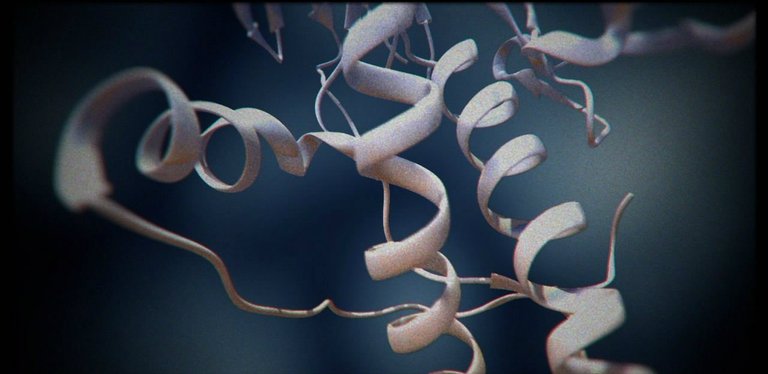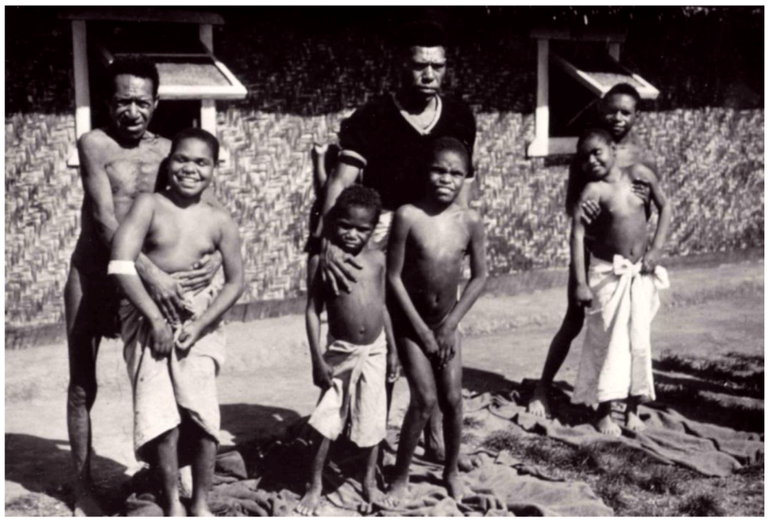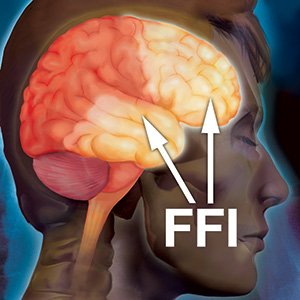
Neurodegenerative diseases - a group of slowly progressive diseases that affect the nervous system. Some are more common, others - less. They can be inherited or be acquired. Some of them are treatable, and other drugs have not yet invented.
Today we will talk about two rare neurodegenerative diseases - diseases kuru and fatal familial insomnia (FFI). From the first time suffered a tribe in Papua New Guinea, the second still is haunted by the same Italian family. At first glance between these diseases is nothing in common, but as usually happens in life, it is actually not so straightforward.
Kuru disease.

Almost no one in the world until the 1930s did not know anyone lived in the highlands of Papua New Guinea. The Company remained in the dark for as long as the Australian miners have not studied the area and found about a million people.
The first explorers traveled to the area in 1950, and immediately discovered something disturbing. The Fore tribe of about 11,000 people die each year 2% of the population of an unknown science illness. Tribal residents called it "kuru", which means "trembling" or "damage".
Local know if the first symptoms appear, death is inevitable. First, patients experience difficulty walking, which further leads to a complete loss of control of limbs. They also lost the ability to manage their emotions. For this reason, some of the publications that subsequently wrote about this disease, called her "laughing death." A year later, the patients were not able to get up from the floor, and have their own control your body. The disease is described in detail in 1957 by two doctors: Daniel Carleton Gajdusek and Vince Zigas.
Foret were convinced that kuru cause evil shamans. First of all disease affects adult women and children under 8 years. Some villages have completely lost young women. Residents were obsessed in trying to save themselves, because they felt that their family is on the verge of extinction.
What caused this illness? The answer to this question was given to scientists for many years. When the researchers tested the area and the effects of pollutants, they decided that the most likely genetic disease. It was the first major misconception among scientists about the nature of the disease. Subsequently, scientists have found that kuru - not a genetic disease, as it affects in the same social groups of women and children, but not genetic. Kuru first appeared in the northern villages at the turn of the century, and then for decades moved south.
Once scientists have ruled out the possibility of transmission of kuru inherited, they decided, though the disease - a manifestation of the slow virus. To confirm this hypothesis, the group come to grips with research.
Later Gajdusek and Zigas guessed what was going on: the disease is associated with funeral rites adopted in Fore tribe, namely eating corpses. In many villages, when a man died, the woman was removed from the body of the brain, it was mixed with ferns and cooked it in a bamboo bowl. The remaining part of the body was prepared in the fire and ate everything except the gall bladder, a sign of love and sorrow. The ritual involved mostly adult women, because it was thought that their bodies tamed a dangerous spirit, who will accompany the body to the other world. Sometimes, in honor of the women were given small portions of these foods to your children. This explains the mortality among women and children.

However, scientists did not have direct proof of the theory. Then they conducted an experiment on chimpanzees: they entered the brain material of an infected person. In animals, symptoms of kuru emerged that led scientists to think that the cause is really slow virus with abnormally long incubation period: the people he was from 2 to 23 years. For the discovery of the contagious nature of the disease kuru Carlton Gajdusek was awarded the 1976 Nobel Prize in Physiology or Medicine Prize.
Later his theory recognize erroneous: kuru agent was not a virus, bacterium, fungus or parasite - that was completely new at the time an infectious agent, who had no genetic material could survive boiling and thus was not alive. As it turned out a group of researchers led by Stanley B. Prusiner, the agent will kuru protein with abnormal tertiary structure and containing no nucleic acid - a prion.
The structure of the prion protein and its replication is of fundamental importance in the study of kuru. Although the precise details concerning the structure of prions, were initially unclear Pruziner put forward three hypotheses. He assumed that either viruses or proteins associated with a small polynucleotide or protein, lacking nucleic acid. Numerous studies failed to confirm the latter assumption scientist. Prisoner In 1997 received the Nobel Prize for his discovery of prions - a new biological source of infections.
Under normal conditions, these innocuous cellular proteins, but they have the ability to transform into stable structures, causing a number of neurodegenerative diseases including kuru. Prions "subordinate" willingly healthy proteins and turn them into their own kind. Ultimately, this kind of chain reaction leading to the formation of prions amount sufficient to kill the bundles of nerve cells in the brain.
These proteins are literally transform the cerebellum into a sieve, piercing right through him, because the sick and lose coordination. They also form tangles that impede the flow of natural processes in the brain. Typically, the patient kuru passes through three stages. Preexisting disease headache and joint pain - are common symptoms for which patients often do not pay enough attention. In the first stage, a person with Kuru loses control of his body, have difficulty in balancing and maintaining posture. In the second stage, or "sit-down" stage, the person is deprived of the opportunity to go. It appears tremors in the limbs, and involuntary twitching. In the third step the patient is usually bedridden and can not control most functions of the organism. It may manifest dementia or behavioral change. At this stage the patient having difficulty with swallowing, and it loses the ability to eat the traditional way. In the end, the majority of patients with kuru die from pneumonia.

Ill kuru can only be infected by eating the brain or coming into contact with open wounds or sores of the patient, so we can not talk about the prevalence of this disease. However, this study kuru disease led to the discovery of prions which cause a number of other neurodegenerative disorders: familial fatal insomnia, Creutzfeldt-Jakob disease, Gerstmann–Sträussler–Scheinker syndrome, and others.
Unfortunately, there is no way to cure kuru. Prions that cause this disease are difficult to destroy. Brain, wherein the cellular proteins are worked, even if remains infectious store it in formaldehyde for many years. Therefore, in this case, the best cure - is prevention. So the government and society in the middle of the XX century, sought to prevent the disease, preventing the social practice of cannibalism. Since the 1950s, the Fore tribe abandoned their funeral rites, and now the disease almost completely disappeared. Today kuru rarely diagnosed: symptoms similar to kuru, are more likely to point to other serious neurological disorder or disease sponge.
Nevertheless, disease studies conducted so far. In 2009, a group of scientists at the UK Medical Research Council found that some people who have experienced the epidemic kuru, bear in his body V127 genetic mutation, which confers strong resistance to disease. Perhaps someday scientists will be able to find a drug that can withstand the destructive activity of prions.
Fatal familial insomnia
In 1797 in a small town near Venice she was born a man named Giacomo. Members of his family, as a rule, were all as on selection: tall, broad-shouldered and muscular (however, and the current generation has retained these attractive features). One autumn day in 1836 Giacomo fell with unexplained illness, began to suffer from dementia. In the end, the disease eventually confined him to bed, where he lay in agony without sleep. Shortly thereafter, he died.
In Giacomo left three children, one of them left behind six other heirs. The following half-century his descendants flourished: the family members became prominent Italian doctors and businessmen. Their condition would allow them to own 130 apartments in Venice, including the palazzo on the Grand Canal. But in parallel with a high position in society in the parish books in front of each name standing record of premature death. For decades, they were fixed oddities like epilepsy, fever, fever, accompanied by a gastric disorder. Later in the death certificates of family members will indicate meningitis, encephalitis economy, Alzheimer's disease, panencephalitis, alcoholic encephalopathy and other diseases.
In fact, the cause of death in all cases was one - fatal familial insomnia. This genetic disease has not been officially defined until 1986. It is so rare that a long time, only the descendants of Giacomo were the only people in the world affected by this disease. Since then, it has been found another 30 families have been subjected to fatal familial insomnia.
The overall picture looks fairly gloomy symptoms. The first signs of fatal familial insomnia may be found in aged 32-62 years, mean age - 51 year. But there are cases when the disease is advancing, and 18 years and 72 years. The first and the main sign of the disease is progressive with time insomnia.
At the first stage the patient will try to compensate for lack of sleep afternoon nap, but usually it is not possible. Pupils are tiny, pressure - increased. There is a strong sweating, impotence in men occurs. About four months later, he suffers from panic attacks and phobias unexplained.
During the following months of fighting with the disease the patient is trying to get to sleep, but every time he closed his eyes, he will reach a maximum of light torpor, trance. The brain stops to rest. Panic attacks are serious and will last about five months.

and the third stage of total insomnia causes rapid weight loss and limitations in mental functioning. This stage lasts about three months. At the last stage the patient is completely weakened and suffering from dementia, and resistance to the outside world for about six months. Then it waits for coma and death. One of the most tragic aspects of the disease lies in the fact that despite the fact that the patient is showing all the signs of dementia, he clearly understands what is happening to him.
At least 30 of the children died Giacomo in such a way in the last century - 13 in 1973 and 7 in the last decade. Among people living around 25 carry the gene that causes the disease. In the area of Venice in Italy, where he still lives most of the family, long version was circulated widely that the descendants of Giacomo damned. Local people do not stop to discuss the tragic fate of the family, which can not but affect its continued existence. Young girls from the family is difficult to find a partner in life, despite their visual appeal and decent condition. Even goes so far, that the family members can not get insurance.
In the mid 80-ies of the last century, the history of the descendants of Giacomo interested in Italian newspapers. The rich family with an unexplained illness became exotic. Media attention had at that time, when the first reports of a new European scourge - mad cow disease. As it turned out, both of these agents of disease combined - prions.
In almost every case, fatal familial insomnia is caused by a mutation in the PRNP gene. This mutation means that the protein which contains this gene, aspartic acid replaces asparagine at position 178, converting a prion protein. But this is not enough for the emergence of the disease. To the symptoms of the disease appeared in Prione be present amino acid methionine at position 129 of the protein. Together with amino acids, asparagine and methionine in these specific positions acquire pathological prions conventional form.
There are rare cases when the disease is not due to changes in the genes. As of 2016 recorded only 24 such cases. Here, fatal familial insomnia occurs when some of the normal human prions spontaneously transformed into an abnormal shape, which causes the disease, prions and then changes in other cells, as in the case of kuru disease.
Prions, the abnormal gains shape cause changes in the thalamus - the brain region responsible for the redistribution of information from the senses (except smell) to the cerebral cortex. The same region controls the sleep cycle, a sense of balance, a feeling of pain, learning aspects, memory, speech and language understanding. Even the emotional experience and character depend on the thalamus.
When the fatal familial insomnia is caused by mutations in the PRNP gene is inherited in an autosomal dominant manner. This means that for the occurrence of the disease is enough to have one allele in Muta asexual chromosome. In some cases, a person inherits the mutation from an affected parent disease. In other cases, the disease can result from mutations in a new gene.
The man with the fatal familial insomnia in 50% of cases, transfers the gene to their children. Sometimes it happens that the disease is not inherited, provided that the disease is caused by a spontaneous change in prions and not caused by genetics.
Like kuru, fatal familial insomnia can not cure or slow its progression. You can only alleviate the symptoms and to create the most comfortable environment possible around the patient.
Referenced Materials:
- https://en.wikipedia.org/wiki/Neurodegeneration
- https://en.wikipedia.org/wiki/Kuru_(disease)
- https://en.wikipedia.org/wiki/Fatal_familial_insomnia
- https://en.wikipedia.org/wiki/Fore_people
- https://en.wikipedia.org/wiki/Prion
- https://en.wikipedia.org/wiki/Creutzfeldt–Jakob_disease
- https://en.wikipedia.org/wiki/Gerstmann–Sträussler–Scheinker_syndrome
- http://www.nejm.org/doi/full/10.1056/NEJMoa0809716
- https://en.wikipedia.org/wiki/PRNP
- http://www.mdpi.com/2076-0817/2/3/472/htm
This post looks like being a google (or similar) translation from this original Russian article. If you translate something, please indicate it clearly as a matter being fair with your referencing. Also, note that translating a post without the consent of the original author is simply plagiarism, in particular as you claim the work above to be yours (by adding references that it is clear you haven't used). Plagiarism is not well accepted on steemit, as you should know...
I am a bit disappointed as I was following you for weeks and I actually enjoyed the topics you were discussing. I was not expecting this from you :(
This is my article and I translated it.